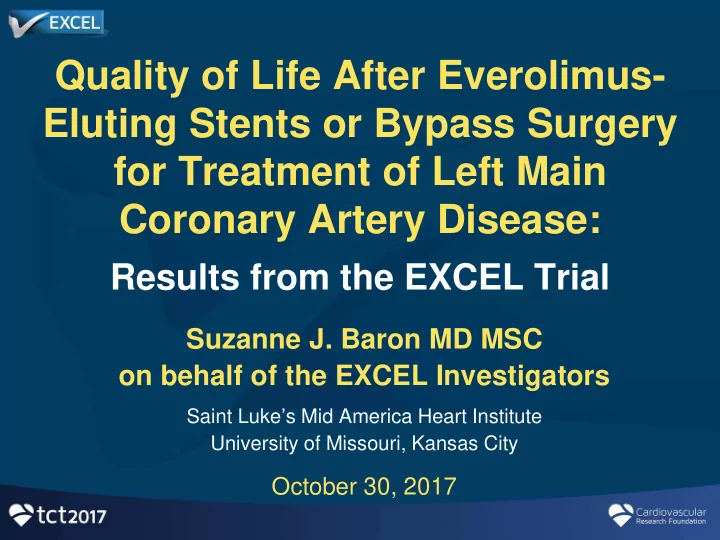

Quality of Life After Everolimus- Eluting Stents or Bypass Surgery for Treatment of Left Main Coronary Artery Disease: Results from the EXCEL Trial Suzanne J. Baron MD MSC on behalf of the EXCEL Investigators Saint Luke’s Mid America Heart Institute University of Missouri, Kansas City October 30, 2017
Disclosures • Within the past 12 months, I have had a financial interest with the organizations listed below: Consulting Fees: Edwards LifeSciences; St. Jude Medical Inc Travel Reimbursement: Medtronic • The EXCEL trial was funded by Abbott Vascular, Inc.
Background
Background
Objectives
EXCEL QoL Sub-Study Design
Disease-Specific Health Status Instruments Instrument Description/Role • Assesses CAD-specific health status • Domains: Angina Frequency; Physical Seattle Angina Limitations; Quality of Life; Angina Stability; Questionnaire Treatment Satisfaction (SAQ) • Scores: 0 to 100 with higher scores indicating less severe symptoms
Disease-Specific Health Status Instruments Instrument Description/Role • Assesses CAD-specific health status • Domains: Angina Frequency; Physical Seattle Angina Limitations; Quality of Life; Angina Stability; Questionnaire Treatment Satisfaction (SAQ) • Scores: 0 to 100 with higher scores indicating less severe symptoms • Assesses patient’s level of dyspnea with activity Rose Dyspnea Scale (RDS) • Scores: 0 to 4 (0 = no dyspnea; 4 = dyspnea with minimal activity)
Generic Health Status Instruments Instrument Description/Role • Assesses general physical and mental health Medical Outcomes Study • Physical & Mental Summary Scores standardized Short-Form-12 such that population mean is 50 with SD of 10 with higher scores indicating better QoL (SF-12)
Generic Health Status Instruments Instrument Description/Role • Assesses general physical and mental health Medical Outcomes Study • Physical & Mental Summary Scores standardized Short-Form-12 such that population mean is 50 with SD of 10 with higher scores indicating better QoL (SF-12) • Assesses sx associated with clinical depression Patient Health • Scores: 0 to 24 with higher scores indicating Questionnaire-8 worse depression (PHQ-8) • PHQ- 8 ≥ 10 corresponds to significant clinical depression
Generic Health Status Instruments Instrument Description/Role • Assesses general physical and mental health Medical Outcomes Study • Physical & Mental Summary Scores standardized Short-Form-12 such that population mean is 50 with SD of 10 with higher scores indicating better QoL (SF-12) • Assesses sx associated with clinical depression Patient Health • Scores: 0 to 24 with higher scores indicating Questionnaire-8 worse depression (PHQ-8) • PHQ- 8 ≥ 10 corresponds to significant clinical depression • Generic instrument for assessment of health EuroQOL utilities (EQ-5D) • Scores: 0 to 1 (0 = death; 1 = perfect health)
Statistical Methods • Within-group comparisons performed using Student t -tests to evaluate changes between baseline and follow-up • Between-group comparisons performed using longitudinal random-effect growth curve models • Exploratory subgroup analyses performed to assess whether the effect of PCI vs. CABG on the SAQ- angina frequency scale at 12 and 36 months varies according to baseline patient characteristics Threshold for significance < 0.01 given multiple comparisons
Baseline Clinical Characteristics * Core-lab defined
Baseline Quality of Life Disease-Specific Measures
Baseline Quality of Life Generic Measures
Clinical Outcomes at 36 Months * For full trial population
Clinical Outcomes at 36 Months * For full trial population
SAQ-Angina Frequency
SAQ-Angina Frequency
Rose Dyspnea Scale
SF-12 Physical Summary Scale
SF-12 Mental Summary Scale
PHQ-8 Clinically Significant Depression * * PHQ-8 > 10
Subgroup Analyses SAQ-Angina Frequency Scale at 1 Year
Subgroup Analyses SAQ-Angina Frequency Scale at 3 Years
Comparison of QoL Outcomes with Other PCI vs. CABG Trials 1 2 EXCEL SYNTAX FREEDOM 1. Abdallah et al. JACC 2017; 69: 2039-50. 2. Abdallah et al. JAMA 2013; 310: 1581-90.
Comparison of QoL Outcomes with Other PCI vs. CABG Trials 1 2 EXCEL SYNTAX FREEDOM LMCAD with 3V CAD or MV CAD Population SYNTAX ≤ 32 LMCAD in diabetics 1. Abdallah et al. JACC 2017; 69: 2039-50. 2. Abdallah et al. JAMA 2013; 310: 1581-90.
Comparison of QoL Outcomes with Other PCI vs. CABG Trials 1 2 EXCEL SYNTAX FREEDOM LMCAD with 3V CAD or MV CAD Population SYNTAX ≤ 32 LMCAD in diabetics Long-Term No Better with Better with Angina Relief difference CABG CABG 1. Abdallah et al. JACC 2017; 69: 2039-50. 2. Abdallah et al. JAMA 2013; 310: 1581-90.
Comparison of QoL Outcomes with Other PCI vs. CABG Trials 1 2 EXCEL SYNTAX FREEDOM LMCAD with 3V CAD or MV CAD Population SYNTAX ≤ 32 LMCAD in diabetics Long-Term No Better with Better with Angina Relief difference CABG CABG CABG better CABG better with Subgroup No with greater greater anatomic Effects difference anatomic complexity and with complexity more baseline angina 1. Abdallah et al. JACC 2017; 69: 2039-50. 2. Abdallah et al. JAMA 2013; 310: 1581-90.
Why the Discrepancies?
Summary and Conclusions
Summary and Conclusions
Recommend
More recommend